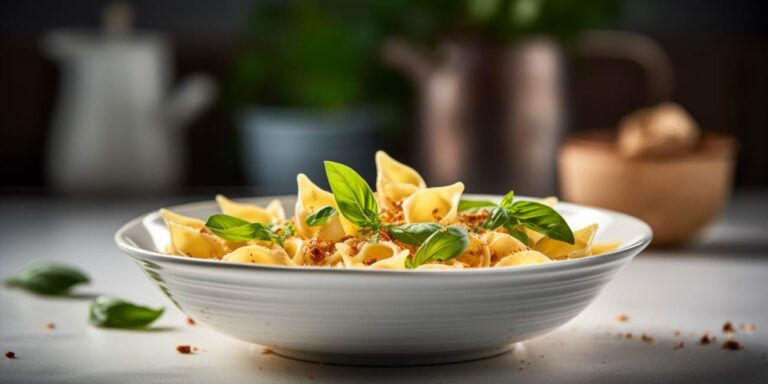Cappelletti pasta, also known as „little hats,“ is a delightful Italian stuffed pasta variety that has been enjoyed for generations. These small, hat-shaped parcels are typically filled with a savory mixture and served in a delectable broth or sauce. In this article, we’ll explore the origins of cappelletti pasta, how to prepare it, and the best ways to savor this Italian culinary treasure.
Origins and history
Cappelletti pasta is believed to have originated in the Emilia-Romagna region of Italy, which is famous for its rich culinary traditions. This stuffed pasta variety has a history that dates back centuries and is an integral part of Italian culture. The name „cappelletti“ is derived from the Italian word „cappello,“ meaning hat, which aptly describes the pasta’s distinctive shape.
Ingredients and filling
Creating cappelletti pasta involves a few key elements: the pasta dough and the filling. The dough is typically made with flour and eggs, creating a supple yet sturdy shell for the filling. The filling can vary, but a classic choice is a blend of ground meat, such as pork or beef, mixed with Parmigiano-Reggiano cheese, nutmeg, and often, a hint of prosciutto.
The ratio of pasta to filling is crucial. Traditional cappelletti is known for its delicate balance between the dough and the filling, resulting in a harmonious, flavor-filled bite.
Preparation
Making cappelletti pasta from scratch can be a labor of love, but the results are well worth the effort. Here’s a basic guide to crafting your own cappelletti:
- Prepare the pasta dough by mixing flour and eggs until it forms a smooth, elastic ball of dough.
- Roll out the dough into thin sheets, ensuring it’s not too thick.
- Cut the dough into small, square or round shapes.
- Place a small amount of filling in the center of each piece of dough.
- Fold the dough over to create the classic hat shape, sealing the edges tightly.
- Boil the cappelletti in salted water until they float to the surface, indicating they are ready to be served.
Once cooked, cappelletti pasta can be enjoyed in various ways, depending on your preference.
Serving suggestions
There are several delightful ways to savor cappelletti pasta:
- Broth: Cappelletti in broth is a classic and comforting dish. The pasta parcels are gently simmered in a flavorful broth until they absorb the liquid and become tender.
- Sauce: Cappelletti can also be served with a rich pasta sauce, such as a creamy Alfredo or a savory Bolognese. The sauce complements the pasta’s filling, creating a delicious combination.
- Butter and Sage: Another popular preparation involves sautéing the cooked cappelletti in butter and sage. This simple yet flavorful dish highlights the pasta’s taste and texture.
Frequently asked questions (faqs)
What is the meaning of „cappelletti“ in italian?
In Italian, „cappelletti“ means „little hats.“ The name perfectly describes the pasta’s unique hat-like shape.
Can i use a vegetarian filling for cappelletti pasta?
Yes, you can certainly use a vegetarian filling for cappelletti pasta. Some popular vegetarian options include a mixture of ricotta cheese, spinach, and Parmesan, or a combination of mushrooms, herbs, and cheese for a delightful meat-free alternative.
What is the best way to store homemade cappelletti pasta?
To store homemade cappelletti pasta, place the uncooked pasta in a single layer on a baking sheet and freeze until solid. Then, transfer the frozen pasta to an airtight container or resealable plastic bags and store them in the freezer. This will prevent them from sticking together, and they can be cooked directly from frozen.
Is cappelletti pasta the same as tortellini?
Cappelletti and tortellini are similar in that they are both stuffed pasta varieties. However, there are slight differences in their shapes and regional variations. Cappelletti are typically hat-shaped, while tortellini have a more distinctive ring shape. The fillings and regional traditions can also differ.
Siehe auch:






